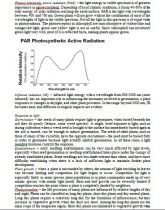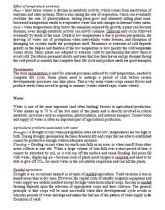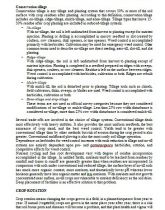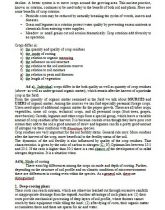Hledej
Zobraz:
Univerzity
Kategorie
Rozšířené vyhledávání
12 663
projektů
Environmental Factors Affecting Crop Production
| Přípona .doc |
Typ přednášky |
Stažené 0 x |
| Velikost 1,5 MB |
Jazyk anglický |
ID projektu 3654 |
| Poslední úprava 16.06.2014 |
Zobrazeno 1 325 x |
Autor: eliseus |
 Sdílej na Facebooku
Sdílej na Facebooku |
||
| Detaily projektu | ||
- Cena:
2 Kreditů - kvalita:
84,2% -
Stáhni
- Přidej na srovnání
- Univerzita:Česká zemědělská univerzita v Praze
- Fakulta:Fakulta životního prostředí
- Kategorie:Přírodní vědy » Ekologie a environmentalistika
- Předmět:Životní prostředí
- Studijní obor:-
- Ročník:-
- Formát:MS Office Word (.doc)
- Rozsah A4:21 stran
All crops differ in their biological characteristics and their environmental requirements, while the physical character of the earth’s surface varies greatly from place to place. A great many variables influence plant growth, including day-length, the amount of solar energy received, the amount of precipitation available for transpiration, temperature during growing season and others. Many of these variables, all critical for successful plant growth, can be modified by farmer. But all these modifications of the natural environment are costly. There are, however, some parts of the earth’s surface where a particular crop will grow best without these modifications, and a knowledge of such places helps to explain the distribution of crops.
Light
Solar radiation
Solar radiation is radiant energy (particularly electromagnetic energy) emitted from the surface of the sun, which is powered by nuclear fusion. The electromagnetic radiation emitted by the sun shows a wide range of wavelengths. Fortunately, the highly injurious ionizing radiation does not penetrate the earth's atmosphere. About half of the radiation which reaches the earth surface is in the visible short-wave part of the electromagnetic spectrum. The other half is mostly in the near-infrared part, with some in the ultraviolet part of the spectrum.
Light
Solar radiation
Solar radiation is radiant energy (particularly electromagnetic energy) emitted from the surface of the sun, which is powered by nuclear fusion. The electromagnetic radiation emitted by the sun shows a wide range of wavelengths. Fortunately, the highly injurious ionizing radiation does not penetrate the earth's atmosphere. About half of the radiation which reaches the earth surface is in the visible short-wave part of the electromagnetic spectrum. The other half is mostly in the near-infrared part, with some in the ultraviolet part of the spectrum.
Klíčová slova:
enviroment
crop production
temperature
solar radiation
climate
Obsah:
- Light
Temperature
Water
Climate
Agricultural production areas
SOIL TILLAGE
Conventional tillage
Conservation tillage
CROP ROTATION
1. Deep-rooting plants
2. Shallow - rooting plants
WEED MANAGEMENT
Preventive weed management
Mechanical weed management
Biological weed management
Chemical weed management
Plant Diseases
Noninfectious Agents of Plant Disease
Pests
Pest management strategies:
Outline of methods for managing plant-parasitic nematodes in agriculture.
Outline of some methods for managing insect pests in agriculture.



